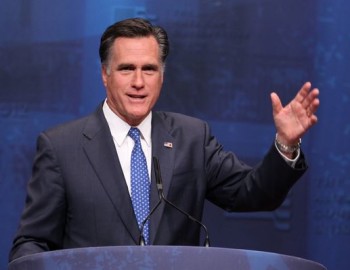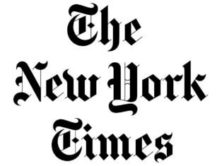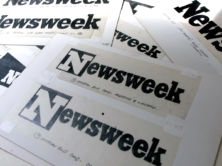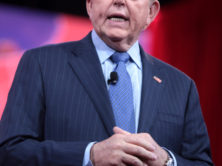
(Credit: Wikipedia)
After some extended soul searching and, more importantly, consultations with political leaders and potential funders across the country, Mitt Romney has decided not to compete for the presidency yet again.
That decision comes despite what Mark Halperin described as “a host of emphatically encouraging poll numbers.” They suggested Romney held leads in the first four “carve out” states (states that are allowed to start their primaries or caucuses before all the others) of Iowa, New Hampshire, South Carolina and Nevada.
Moreover, a specially funded, extended poll of voters in the first twenty states to hold nomination contests showed Romney “with a huge lead across the board, and significantly better favorable/unfavorable ratings than the rest of the large potential field.”
So, what happened to dissuade Romney from taking the presidential plunge a third time? According to the prevailing electoral paradigm, the Republican voters should have been given the opportunity to decide whether they wanted him as their nominee – and from what the polls indicated, they were likely to give a thumbs up.
One argument could be that no Republican candidate has a chance against Hillary Clinton, who is overwhelmingly likely to be the Democratic Party’s nominee, should she decide to run. Several recent polls suggest she has a double-digit lead over the major GOP candidates, though New York Times columnist, Brendan Nyhan, warns against trusting the polls this early in the election cycle. They’re simply not accurate predictors of actual election results, he writes.
Actually, they’re not even accurate predictors of each other! As shown in the graph below, recent polls presuming to measure voter sentiment produce wildly different results.

The ABC/Washington Post poll, conducted over virtually the same time period as the Democratic-leaning Greenberg, Quinlan, Rosberg (GQR) poll, found a 15-point lead for Clinton, while the GQR poll showed only a 6-point lead.
Two polls in early December, and one in late November, also reported highly contradictory results: Clinton with a 12-pont lead over Romney according to McClatchy-Marist, a 6-point lead according to Bloomberg, and a one-point deficit according to Quinnipiac.
Thus, despite some polls showing large leads right now for Clinton over almost any GOP candidate, most pundits and political leaders don’t really believe the polls are accurate reflections of voter preferences. The actual election is likely to show a fairly close contest, given that party identification these days is closely divided between Democrats and Republicans, with most “independents” leaning to either of the two major parties.
If the polls aren’t very accurate predictors of the general election, they’re even worse predictors of primary and caucus contests – at least this early in the nomination process.
The Invisible Primary
It therefore seems unlikely that the polls were much of a factor in Romney’s decision. More important were the reactions among the party elite (including donors) he received to his announcement that he was considering a third run. They were not especially positive.
That the party elites exert such influence was not supposed to happen. Since the latter part of the 19th century well into the 20th Century, it was, of course, the party leaders who exerted effective control over the nomination process. For all practical purposes, they picked the delegates to the national conventions that decided on the party’s presidential nominee, and they bargained among themselves as to which of their party’s leading candidates had the best chance to win the general election.
As late as 1968, for example, Hubert Humphrey was able to obtain the Democratic Party’s nomination without having entered a single primary or caucus contest. The party’s leaders coalesced around him, rejecting the candidacies of Eugene McCarthy and other candidates who had competed against each other in the primaries.
All that changed in 1972, when the Democratic Party adopted reforms that essentially required candidates to win their delegates by campaigning in the caucuses and primaries across the country. It seemed that the control of the party leaders had been broken. Candidates like George McGovern in 1972 and Jimmy Carter in 1976 did not enjoy support among the party establishment, but were still able to win their party’s presidential nomination.
In the Republican Party, the party elite’s control seemed to prevail, despite the new rules of delegate selection. But Ronald Reagan’s near victory in 1976 against his party’s incumbent president, Gerald Ford, showed that both parties were experiencing at least a partial shift in power – from the party leaders to the voters (and the media).
But by the 1980s, it appeared that the party leaders were able to reassert control through the “invisible primary.” That is the period leading up to the caucuses and primaries, when party leaders and donors are able to shape the field of candidates and lessen the influence of the primaries.
In 1984, for example, Gary Hart won a stunning victory in New Hampshire and put the establishment favorite, Walter Mondale, on the ropes. But party leaders rallied around the former vice president and helped him win key primaries and eventually the nomination.
In 1988, Bob Dole upset Vice President George Bush in the Iowa Caucuses, and seemed likely to carry that momentum into New Hampshire, and then to the convention. But party leaders again rallied around Bush to help him fend off Dole in New Hampshire and go on to win the nomination.
In 1996, Dole was the establishment favorite, but lost in the New Hampshire primary. Again, the GOP elite helped Dole recover in the South Carolina primary – which was particularly notable, given that the GOP there was much more conservative than Dole.
In 2000, John McCain won big in New Hampshire, but George W. Bush was the establishment favorite, and he went on to win in the subsequent contests.
It’s not that the party establishment in each party has as much control as it used to when the convention system of nomination was in effect. Barack Obama’s upset of Hillary Clinton, the establishment favorite in the early part of the 2008 election cycle, and John McCain’s nomination that year against the GOP establishment’s favorite, Mitt Romney, illustrate the limits of the invisible primary.
Still, to understand why Al Gore did not run again in 2004, and why Romney just announced his non-candidacy, it’s important to recognize the pervasive influence of party elites. In each case, it appears as though the party leaders – for various reasons – were not enthusiastic about a re-run of the previous election cycle. And the candidates judged that without establishment support, they would be unlikely to prevail.
While the early polls may be widely reported and treated as though they provide some insight into the coming nomination process, the truth is they are hardly reliable. More important is the collective judgment of the party elite, especially the donors, whose outsize influence has made independent candidacies virtually impossible.






Comments Terms and Conditions